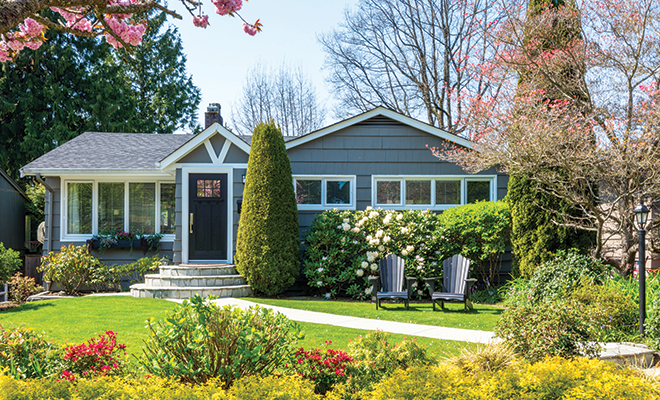
New season, revived landscape
“It’s finally spring! Aren’t you ready to give me a facelift yet?”
That’s your landscaping whining after a long, cold, wet, miserable winter. How are you going to answer this plaintive question?
“I’ll exfoliate your surfaces!”
Make a thorough survey of your yard’s grass and shrubs as the weather clears this month. It may be time to remove thatch, which is the accumulation of dead blades and stems near the soil surface. First, mow the existing grass to a height of about one inch. Then make several perpendicular passes with the mower. Experts also recommend using a vertical mower, which is available at equipment rental stores.
This process will help you determine if there are any areas of damage that will need to be reseeded or sodded. However, if it looks like this will be necessary, you’ll have to wait a while before taking the next recommended step.
“I’ll give you a protective layer!”
Some climates need a pre-emergent herbicide in February or March, but April’s also a good month for this beauty treatment. Weed seeds are present throughout your landscape; whether you see the dandelion puffs blowing or not, they and other annual, biennial or perennial weed seeds will germinate when moisture and soil temperatures give them a boost.
A pre-emergent herbicide establishes a chemical barrier that prevents the seeds from germinating. This barrier lasts six to eight weeks, so apply it as early as possible in the season. Wait a couple of weeks after the de-thatching process so that the grass blades can grow a bit and have a larger surface for the material to attach. For lawns, it’s a bit easier to use a granular product; be sure to follow all instructions on the packaging.
“I’ll give you a good haircut!”
Winter winds and freezing temperatures can be brutal to even hardy trees and shrubs. Frost damage occurs when dropping temperatures condense the moisture in the air onto twigs and leaves; then it freezes. If the plant is still growing or producing fruit, the result can be brown or blackened leaves, stems or fruit; twisted new growth is also a symptom of frost damage.
Clippers and yard shears are the best remedy. In late April or early May, when the meteorologists indicate that damage from late frost has passed, it’s likely safe to trim off damaged or bare limbs and sections of shrubbery. Never remove more than one third of a shrub’s branches at one time to prevent shock to the plant.
“I’ll give you a good rake massage!”
A thorough raking to remove debris, dead leaves, branches and possibly even mushrooms from beds and borders gets rid of an environment that can contribute to fungal growth and more weed germination. It’s tempting to compost this mushy mess, but I prefer to pile it into the trash can for disposal. If your borders are edged with mondo grass, now’s a good time to give it a trim either with the lawnmower or a sharp set of yard shears before the new shoots peek through. Mondo needs a good de-thatch treatment every couple of years to eliminate unsightly buildup of dead grass blades.
Now’s the time to fill these areas back in with the mulch of your choice. It’s also the perfect opportunity to assess adding seasonal annuals or perennials and replace any dead shrubbery. A touch of color with pansies or cool-tolerant flowering plants brightens and lightens your attitude as well as your landscape’s.
“I’ll feed you really well!”
Finally, it’s time to help your grass get the proper nutrients. Test the soil with a kit from the local extension service or a lawn and garden shop; that indicates what product to apply next. Wait at least until April for application; just because temperatures are rising doesn’t mean it’s time yet. The soil temperature should be at least 55 degrees when fertilizer is applied.
My best advice with the application of lawn fertilizer is to be judicious. Don’t apply more than the instructions advise and make sure the type of spreader you’re using is doling out the right dosage. More is NOT better. Last summer, my emerald zoysia was striped until August because the overzealous applicator had a half bag left over and added it for good measure.
“I’ll make you look fun and interesting!”
In addition to creating curb appeal, garden accessories can create a theme or a series of focal points that express your personality. A brightly colored bench can sit by the sidewalk to offer respite for walkers; a blue bottle tree can keep the bad spirits at bay. Why? Because the spirits are so intrigued by the glowing blue light that they slip inside to investigate, and then they’re not smart enough to figure out how to get out of the bottle!
Bright pots filled with drifts of annuals, a chair or two with a table sitting in the shade or a birdbath all welcome you, your neighbors and wildlife to enjoy your lovely, revived, no-longer-whiny landscape! HLM
Sources: hirethegardener.com, gainesville.com, lowes.com, mlive.com, myhomeideas.com, oregonlive.com, redfin.com, Kathryn Tucker Windham and the experience of the author.







